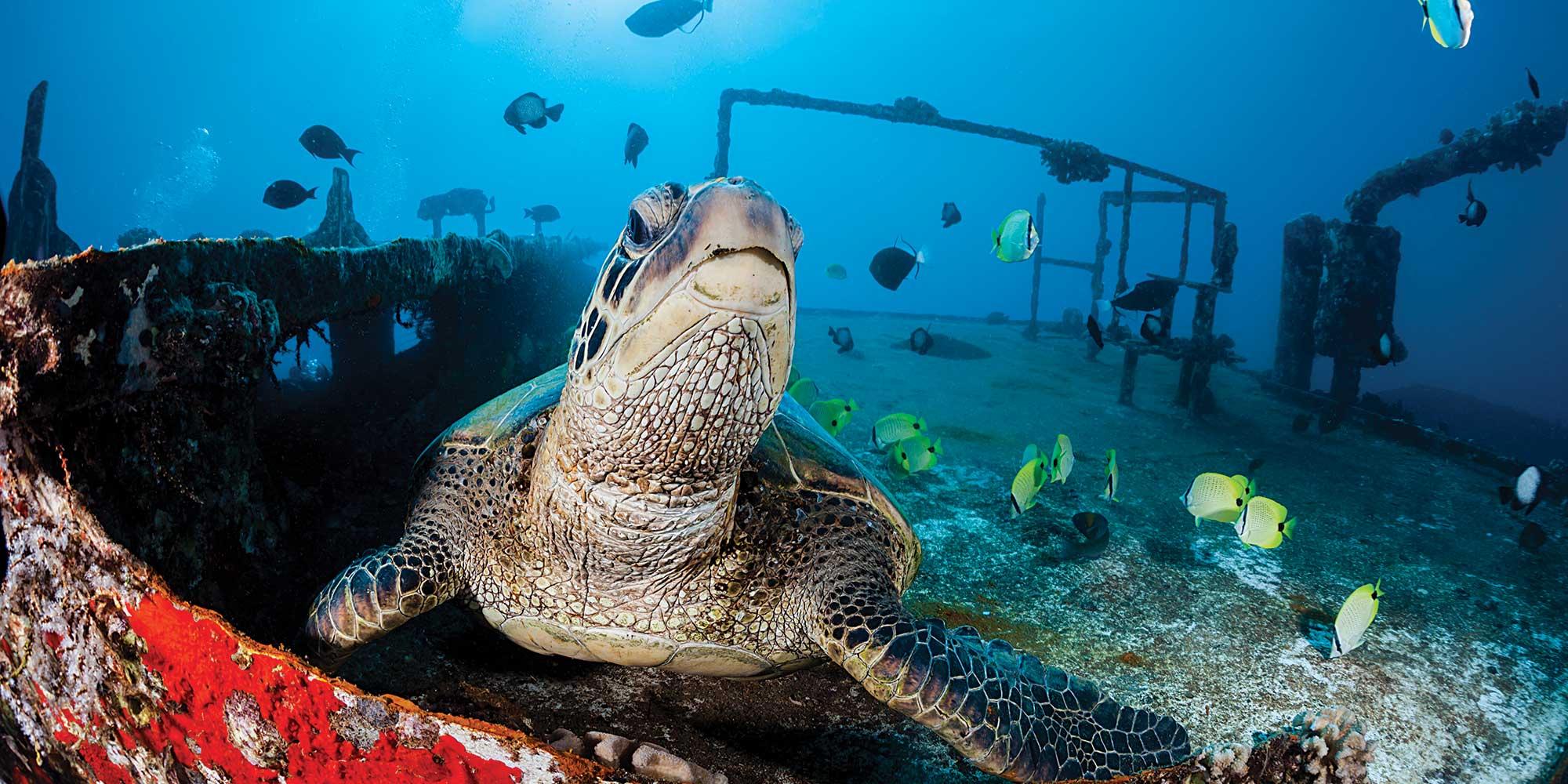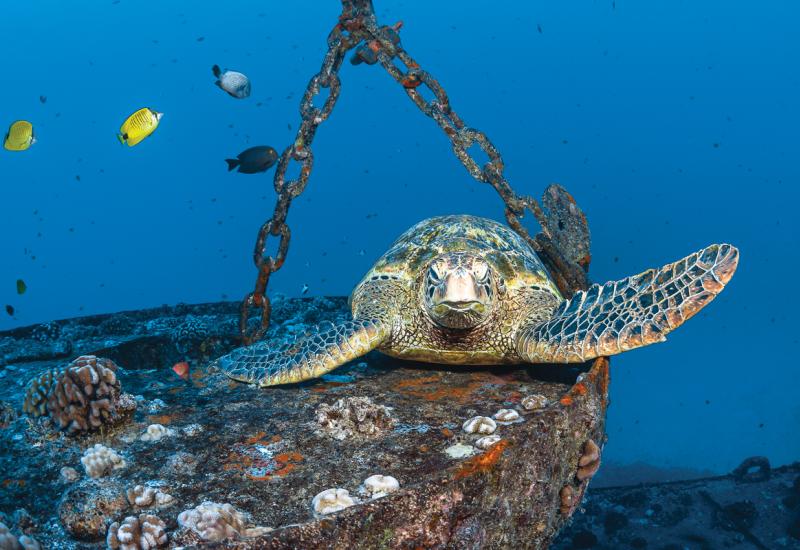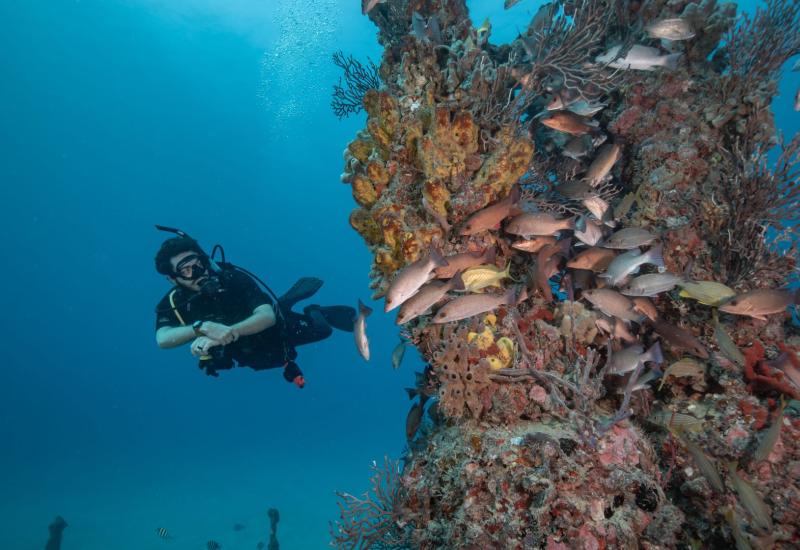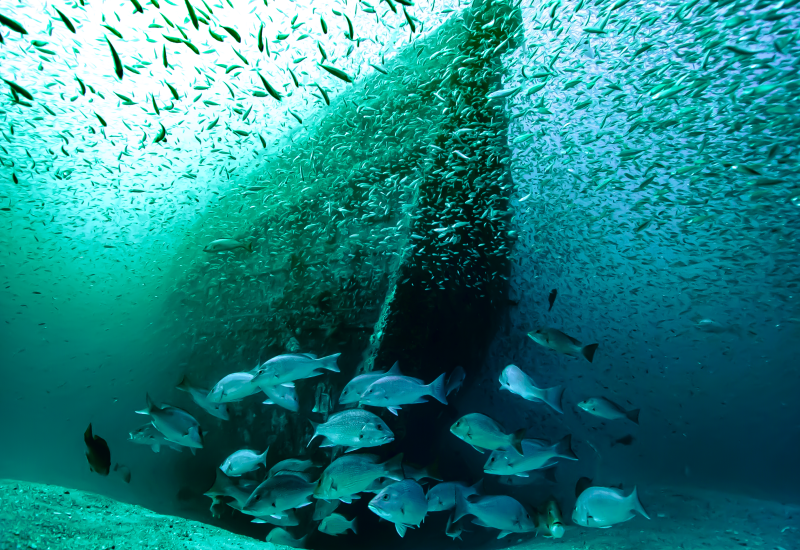Shipwrecks Prime for Near-Guaranteed Marine Life Encounters
At first, it might seem like coincidence when a certain species keeps appearing at a particular wreck. Then, over time, as divers continue to encounter the same marine life—sometimes even the same individuals—at the same wreck, they become linked.
Some sites become synonymous with the life they support, as is the case with these five artificial reefs.
YO-257
Oahu, Hawaii
Green Sea Turtles
Rare is it that a green sea turtle—or several—will stay with divers for the duration of their time underwater, but at the YO-257, this is the norm.
Perhaps it’s due to the wreck’s location near the edge of a drop-off where a strong current wraps around the Diamond Head volcanic cone before flowing past this ledge, creating a bio-rich hotspot. Many fish travel with the flow, including butterflyfish and Hawaiian cleaning wrasse, which have established cleaning stations around the wreck.
“The sea turtles will hang out usually for the whole dive,” says Shelly Rofrits, vice president of Dive Oahu.
Because the wrecks and cleaning stations have a long history, the turtles are well-accustomed to humans.
“They’re not scared of us whatsoever,” Rofrits says. That said, divers should try to minimize movements so as not to startle the turtles.
Doug Perrine, a Hawaii-based underwater photographer, advises: “Place yourself quietly in a spot where you think it will approach you. Make no sudden movements or strong exhalations. Watch the turtle for nervous tics or face swipes with the pectoral fins.”
Those who can restrain themselves will likely be wowed by the experience.
Rofrits says, “It’s kind of surreal to see a 400-pound turtle just relaxing out on a wreck, and you have the privilege of sharing that space with it.”
Specs
In 1989, The Atlantis Submarines Group sank the 174-foot U.S. Navy Yard oiler to a depth of 100 feet to give their guests more to view. The wreck supports myriad life, from nudibranchs to octopuses, and of course, the cleaning-station species.
Tip
“Pay even more attention to the fish working on the turtle. If they start to lift off or show other signs of skittishness, back away calmly,” Perrine says.
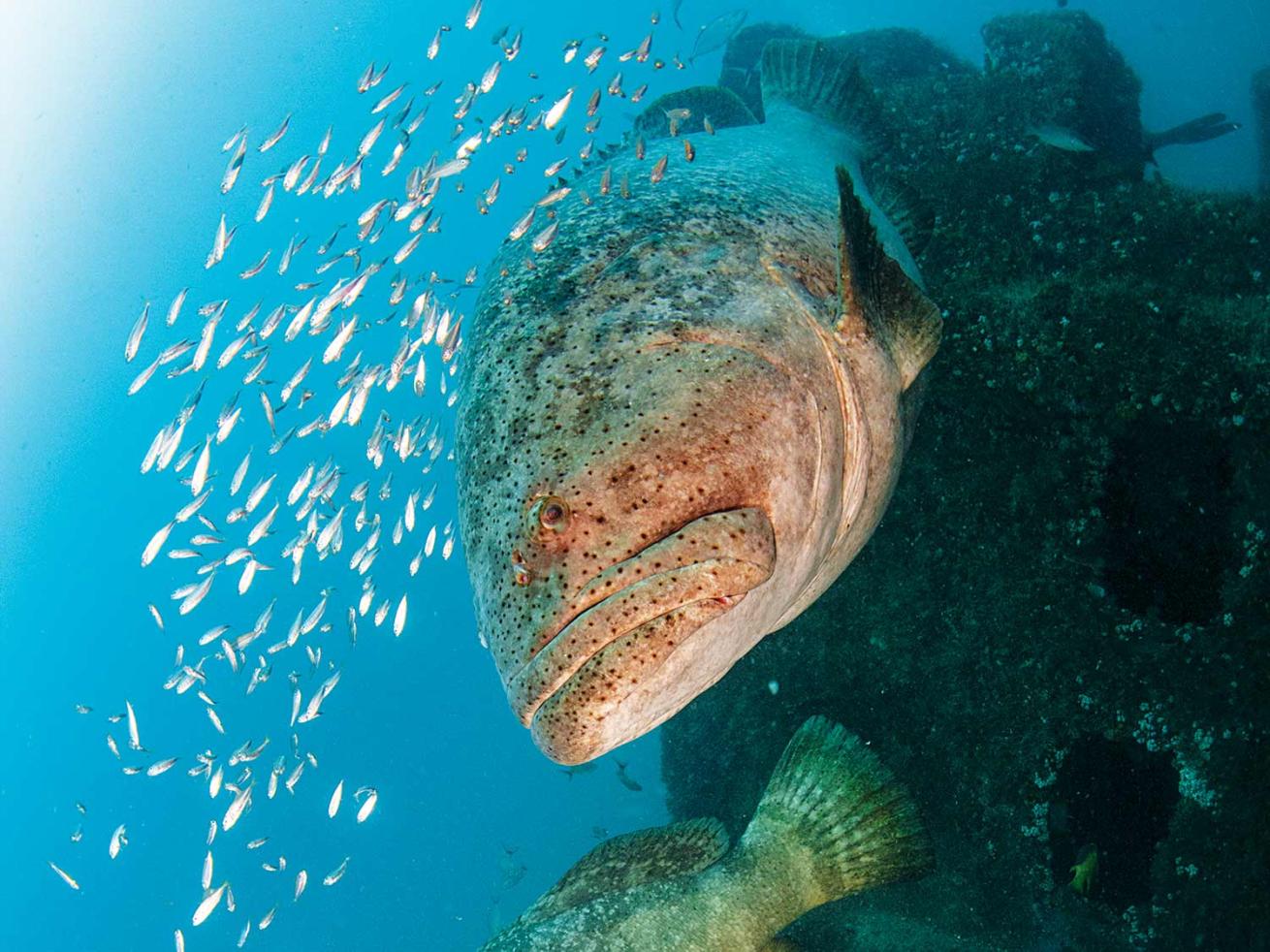
Lureen FerrettiAtlantic goliath grouper can grow up to 800 pounds.
Zion Train
Jupiter, Florida
Goliath Grouper
Goliath grouper are a fixture on many South Florida wrecks, but come August and September, they congregate by the dozens on just a handful of structures—the Zion Train off Jupiter, Florida, among them. That two-month window is the fish’s spawning season, with some days bringing up to 80 to the wreck.
It’s not known precisely why the fish choose the site for spawning, but their predictable patterns suggest they like what the Zion Train offers—that is, a known, locatable structure that points north-south, lying amid strong current.
“They tend to face south, presumably so they get the current over their gills,” says Lisa Carroll, co-owner of Jupiter Dive Center. In other words, they’re able to breathe with minimal energy thanks to the current.
RELATED: Our Readers Vote on the Best Diving in the World
“If you stay low and move slowly, you can get underneath and in the middle of them,” Carroll says.
Which, on a good day, can mean being surrounded by as many as 80 fish, each typically between 4 and 6 feet long.
“The larger resident goliaths, the 7-foot guys, are nowhere to be seen during the aggregation, perhaps because they are outside the age for reproduction—that’s just a guess,” she says.
Still, that’s a lot of fish.
Carroll adds, “Just the sheer fact of the mass and weight of that many fish is amazing.”
Specs
This 164-foot Dutch freighter lies 3 miles outside the Jupiter Inlet. It sits at a depth of 90 feet at the sand, with the structure starting at 70 feet. Swells in 2008 ripped the vessel in half; the stern section sees most of the fish action.
Tip
For the best odds of good photos, Carroll recommends photographers “face north to take advantage of the fish standing still, facing south.”
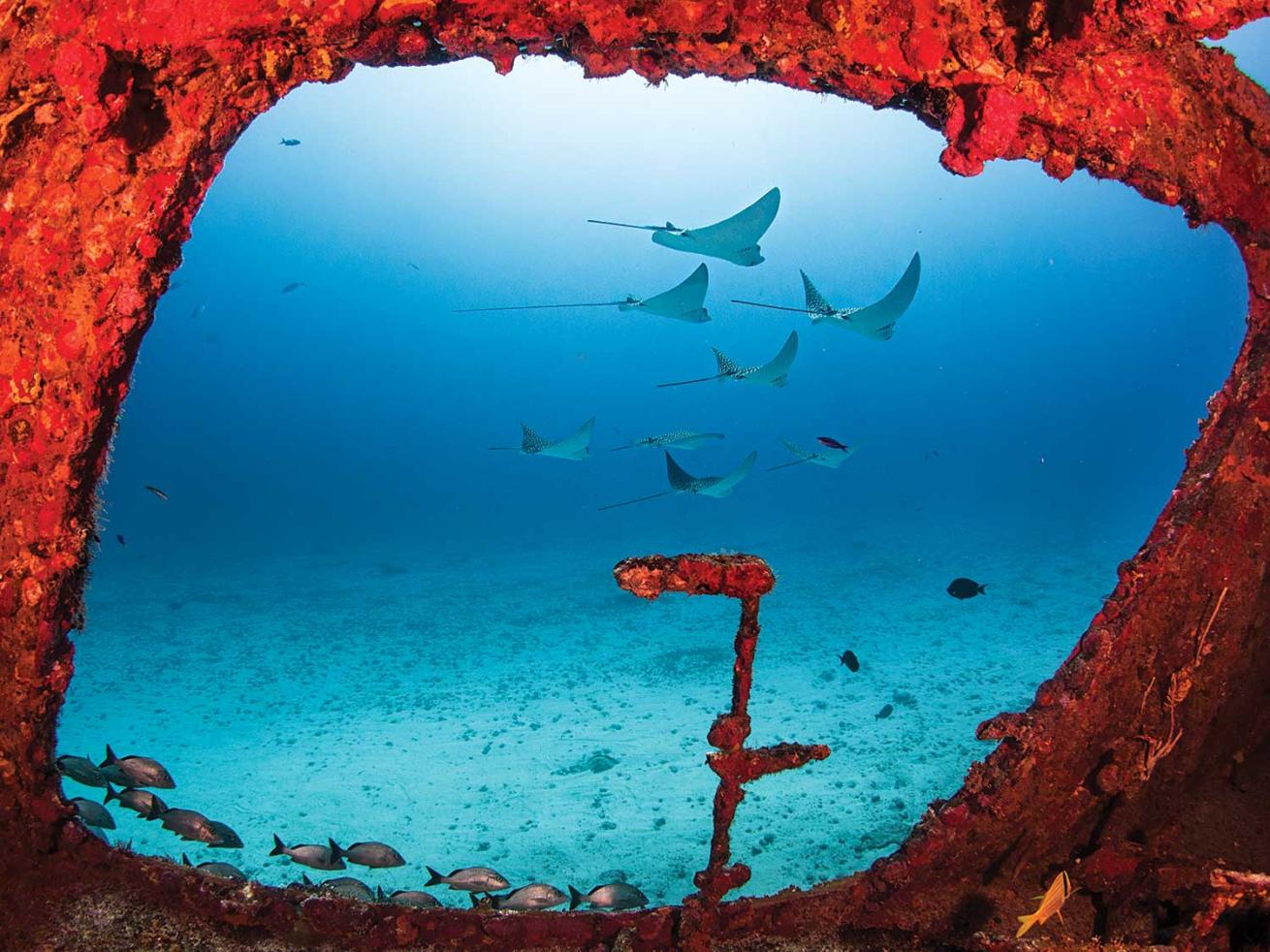
Shane GrossEagle rays are drawn to the C-56 November through February.
C-56
Cancun, Mexico
Eagle Rays
“Protection—that’s why eagle rays come to the C-56,” says Luis Palacios, photo and video manager at Scuba Cancun, a dive operator that visits this purpose-sunk minesweeper off the coast of the popular vacation city in Mexico.
“You’ll always find the rays swimming against the current, making loops around the wreck,” he says.
Scuba Cancun visits the site year-round; however, the eagle rays can be found on the wreck November through February only. At that time, the destination sees cooler water, drawing in the rays, sometimes 20 at a time.
The rest of the year, the individuals that migrate to Mexico have been tracked moving northeast to cooler water off Cuba and Florida.
“They’re almost always moving,” Palacios says. Yet, “they also have a natural propulsion that allows them to move without using their wings. It’s amazing to see. You witness that and think, Wow, how can they do that?”
These moments of stillness also allow divers to observe the rays’ faces. “Some have big noses—well, it’s not a nose, but it looks like a nose,” Palacios says.
Even on a typical dive on this ship, with three to five eagle rays present, divers can witness the fact that these animals are individuals, with no two faces alike.
Specs
When sunk in 2000 to a depth of 100 feet, the intact C-56—aka the Cadete Juan Escutia—was 184 feet long, before 2005’s Hurricane Wilma broke it in two. The rays typically congregate around the stern, the larger of the two chunks. The current at the site is often strong, which typically prevents most divers from edging in close to the animals.
Tip
“Whatever you do, don’t swim like mad to reach them.” Instead, Palacios says, “Don’t kick very fast; don’t move fast—in fact, try to not move much at all.”
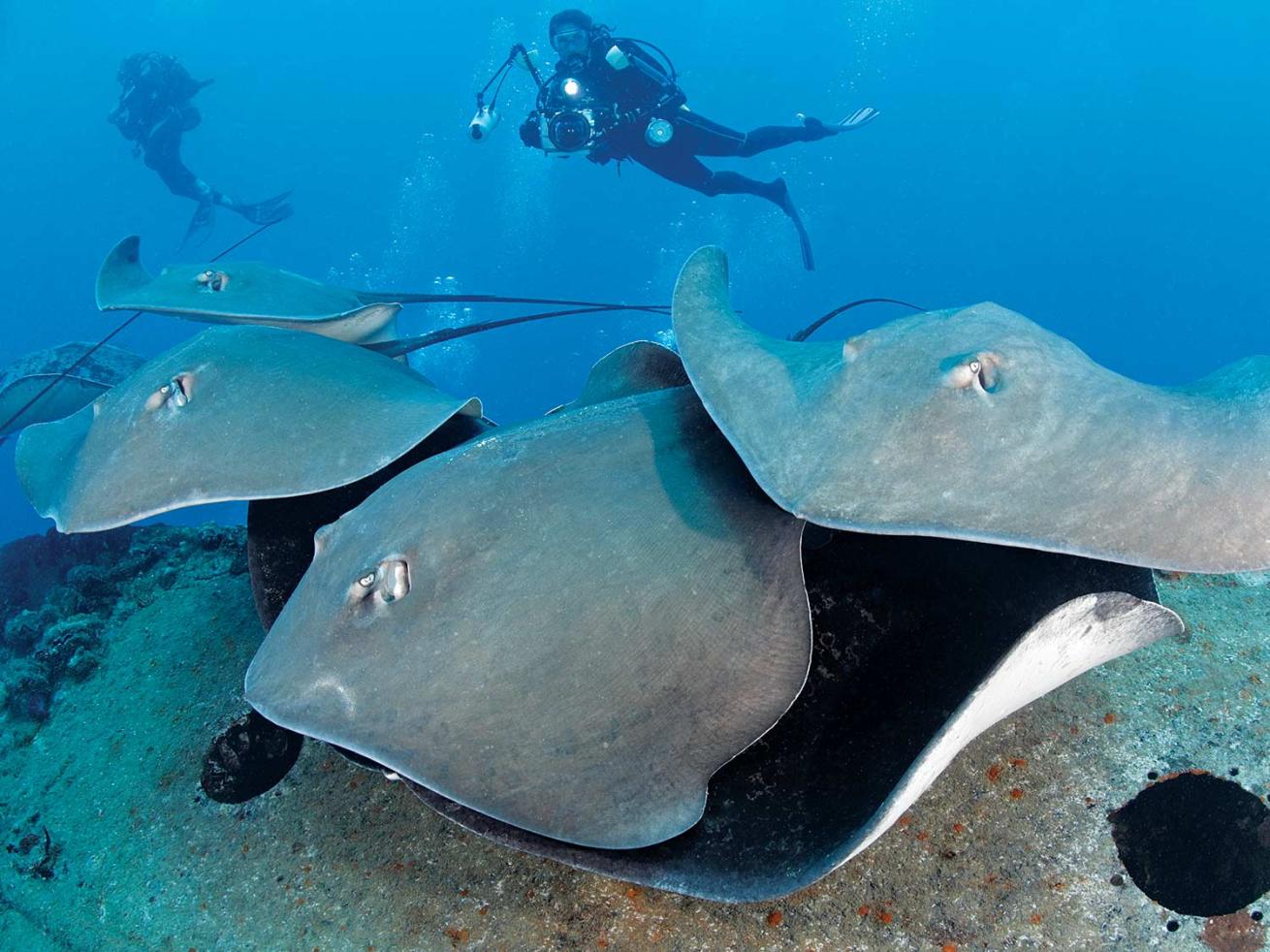
Brandon ColeMarble rays enjoy the proliferation of life on the Yongala
SS Yongala
Queensland, Australia
Marble Rays
Everywhere in the world, when stingrays are sighted, they’re typically bedded down atop the sand—everywhere, that is, except for the SS Yongala, which lies between the Great Barrier Reef and the coast of the Australian state of Queensland.
Reach the top deck when current is running, and you’ll find sometimes two or three, or even a dozen, marble rays “hovering midwater over the structure, which is truly impressive to see,” says Nigel Marsh, Australia-based underwater photojournalist.
Moreover, because this wreck lies amid nothing but sand—12 nautical miles from shore and roughly another 30 nautical miles from the world’s largest coral reef—it is definitely an oasis, attracting sharks, sea snakes, turtles and fish—lots of fish.
“You’ll be completely swamped by schools of fish,” Marsh says.
Thus, the rays—both marble rays and small-eye stingrays, stretching 7 feet across. The rays are all there to take advantage of an endless food chain that makes for a never-disappointing dive.
“You don’t do the dive for the wreck but for the marine life,” Marsh says, of which there is almost always an overwhelming abundance. Because of this, Yongala has earned top honors. “Everyone always lists it not just in their top 10 wreck dives, but within top 10 dive sites—period.”
Specs
A 1911 cyclone claimed this 350-foot passenger ship, sinking it to a depth of 108 feet at the sand, with the structure starting at 50 feet. No penetration is allowed, to prevent any bubbles from hastening deterioration of the interior.
Tip
Leave from Alva Beach, an hour’s drive south of Townsville, where the run to the wreck is about 30 minutes, with favorable weather conditions.
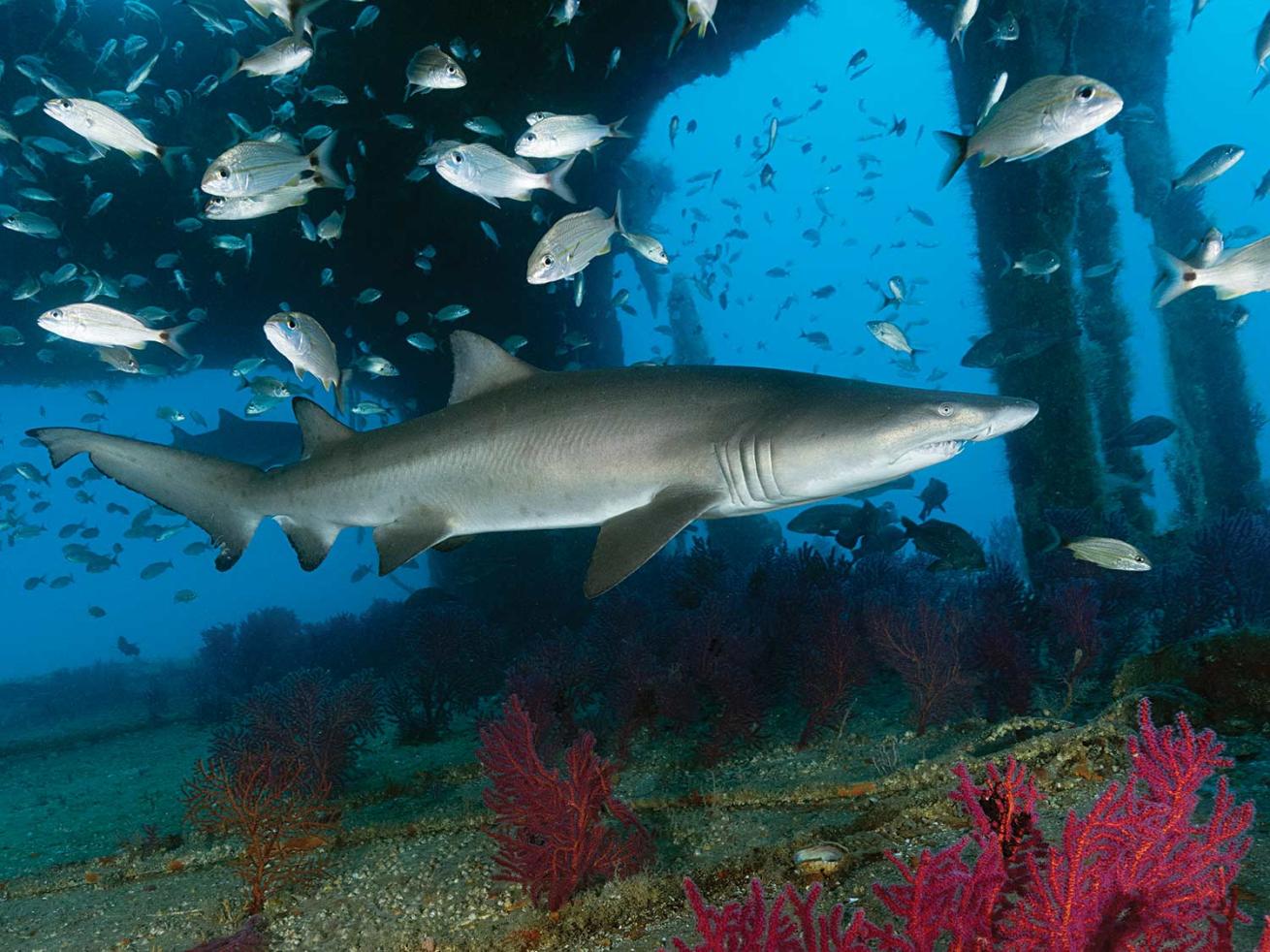
Brandon ColeBusy days could see dozens of sharks around the Aeolus.
Aeolus
Outer Banks, North Carolina
Sand Tiger Sharks
Nobody knows for certain why the sand tiger sharks congregate like clockwork off the North Carolina coast. But what is certain is when—May through October—and where, with the wreck of the Aeolus one of the chief sites for sure-thing encounters.
Says Chris Mason, divemaster with Olympus Dive Center in Morehead City, “You’re pretty much guaranteed to see sand tigers on the Aeolus no matter when it is in the season.”
Those numbers range from one to two on a slow day, to 25 or 30 on days you won’t soon forget.
The Aeolus offers a unique viewing platform, which the divemasters detail in their briefings. One deck down from the top deck, divers can kneel down. The space is much like a room with a giant hole in the ceiling, and two walls removed. In other words, it’s very open—allowing as many as six sand tigers to circle divers within this tight space.
“Your heart does beat a little faster when you have an apex predator inches from your face,” Mason says.
Although they will never make sudden movements toward a diver, they will, Mason says, “turn on a dime and swim away from you.”
As for the question of where they go when they change directions for the season, Olympus is currently working with the North Carolina Aquarium to find answers. Many of the sand tigers that frequently show up have been tagged, and the Aeolus will soon have another receiver installed.
Mason adds, “This research is ongoing, and it’s pretty exciting to be getting closer to answering the whys of these sharks.”
Specs
This 426-foot cable-repair ship was downed in 1988. In 1996, Hurricane Fran carved it into three sections, and displaced sand around the ship, changing the depth from 70 to 75 feet. The stern, however, remains relatively intact.
Tip
“Sand tigers often swim in patterns,” photographer Mike Gerken says. “I try to learn them and set up a desirable section of wreck as a background.”

